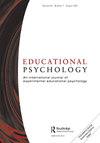诊断儿童和青少年的害羞心理:不同方法的比较分析
IF 3
2区 心理学
Q1 EDUCATION & EDUCATIONAL RESEARCH
引用次数: 0
摘要
这篇文章的目的是讨论用于诊断儿童和青少年害羞的工具。越来越多的学者强调害羞概念的多维性,因为害羞的儿童和青少年表现出各种特定的特征。值得注意的是,不同孩子的羞怯程度相同并不一定会导致相同的行为。此外,在用于诊断儿童和青少年害羞的方法中,可以观察到方法上的显着差异,有些方法比其他方法更能捕捉到害羞的某些方面。此外,用于诊断儿童和青少年害羞的方法的多样性也取决于他们的年龄,有些方法适用于婴幼儿,有些适用于学龄前或学龄儿童,还有一些适用于青少年。最常用的诊断方法包括自我报告问卷或评估问卷。用于诊断害羞的其他方法包括观察、行为实验和社会计量学。虽然这篇文章主要集中在波兰使用的工具,但它提供了关于个别方法的局限性和优点的基本信息。值得注意的是,没有一种方法可以完全捕捉到害羞的现象。因此,将几种方法结合起来似乎是一种合理的方法。在这篇文章中提出的信息强调了使用儿童和青少年害羞诊断工具的各种方法。这些信息有助于专家在选择合适的诊断方法时做出明智的决定。此外,本文可以为进一步研究害羞的诊断提供启发。本文章由计算机程序翻译,如有差异,请以英文原文为准。
Diagnosing shyness in children and adolescents: a comparative analysis of different methods
The aim of the article is to discuss the tools used for diagnosing shyness in children and adolescents. Increasingly, scholars emphasize the multidimensionality of the concept of shyness, as shy children and teenagers exhibit various specific characteristics. It is important to note that the same level of shyness in different children does not necessarily result in the same behaviour. Additionally, among the methods used for diagnosing shyness in children and adolescents, significant differences in approach can be observed, with some methods capturing certain aspects of shyness more than others. Moreover, the diversity of methods used in the diagnosis of shyness in children and adolescents also depends on their age, with some methods intended for infants and toddlers, others for preschool or school-aged children, and others for adolescents. The most commonly used diagnostic methods include self-report questionnaires or assessment questionnaires. Other methods used in the diagnosis of shyness include observation, behavioural experiments, and sociometry. While the article focuses mainly on tools used in Poland, it provides essential information about the limitations and advantages of individual methods. It is important to note that there is no single method that can fully capture the phenomenon of shyness. Therefore, combining several methods seems like a reasonable approach. The information presented in this article highlights various ways of using diagnostic tools for shyness in children and adolescents. This information should help specialists make informed decisions when selecting appropriate diagnostic methods. Additionally, the article can serve as an inspiration for further research on the diagnosis of shyness.
求助全文
通过发布文献求助,成功后即可免费获取论文全文。
去求助
来源期刊

Educational Psychology
Multiple-
CiteScore
6.40
自引率
6.20%
发文量
57
期刊介绍:
This journal provides an international forum for the discussion and rapid dissemination of research findings in psychology relevant to education. The journal places particular emphasis on the publishing of papers reporting applied research based on experimental and behavioural studies. Reviews of relevant areas of literature also appear from time to time. The aim of the journal is to be a primary source for articles dealing with the psychological aspects of education ranging from pre-school to tertiary provision and the education of children with special needs. The prompt publication of high-quality articles is the journal"s first priority. All contributions are submitted "blind" to at least two independent referees before acceptance for publication.
 求助内容:
求助内容: 应助结果提醒方式:
应助结果提醒方式:


